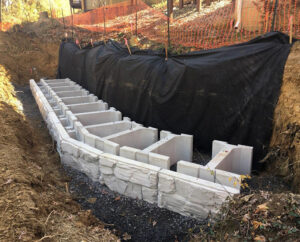The Benefits and Disadvantages of a Retaining Wall
Retaining Wall is a sturdy, structurally sound method of providing usable land on sloped property. Retaining walls can be built of concrete, stone, vinyl, or wood and come in many styles to fit any aesthetic preference.
A retaining wall requires careful design and construction to resist earth pressures that can overturn or push the structure toward failure. Some important considerations include:
The most obvious benefit of a retainer wall is that it can be used to prevent soil erosion. The structure can also be used to improve drainage and enhance the overall appearance of your yard. However, it’s important to note that the benefits of a retaining wall can vary depending on the type and design you choose. A retaining wall can increase the value of your property, improve your outdoor space, and provide added protection from soil erosion, flooding, and other environmental hazards.
A retaining wall can be built from a variety of materials, including concrete, bricks, and stone. The most popular choice is concrete, as it offers a wide range of color and texture options and can match any style of landscaping. It’s also a durable option, able to withstand the pressure exerted on it by soil or other material.
If you want a retaining wall that blends in with your landscaping, consider using natural stone. This option is more attractive than concrete and can help your landscaping look more seamless. However, it’s important to remember that these walls can be more expensive than other options.
Another way to make a retaining wall more visually appealing is to use a concrete block or poured concrete design. These options are typically more affordable than natural stone and offer a variety of colors and textures to choose from. They’re also strong and versatile, so they can be used for a variety of purposes.
When it comes to building a retaining wall, the construction process requires precise measurements and adherence to strict regulations set by local authorities. Fortunately, there are many resources available online that can help you determine the correct height and length for your retaining wall. These tools can save you time and money, as well as ensure that your retaining wall is built safely.
Retaining walls are a great addition to any home, as they add both beauty and functionality. They can also reduce the risk of soil erosion and flooding by directing water away from structures and toward lower-lying areas. They are also a good investment for your property, as they will increase its value and protect it from damage caused by floods and soil erosion.
Cons
Retaining walls are primarily used to prevent soil erosion in homeowner’s yards and provide aesthetically-pleasing landscaping features. However, they also have several disadvantages that homeowners should be aware of before investing in a retainer wall for their property.
A common problem with retaining walls is that they can obstruct views from the property, both from the street and inside the house. If you are planning on constructing a retaining wall, consider choosing a more aesthetically-pleasing material like stone or brick to avoid blocking your view.
Another issue with retaining walls is that they may attract termites. Using timber in the construction of your retaining wall is risky, as it can rot and become a nesting place for termites. Concrete walls are a better choice, as they do not attract insects and are durable. However, concrete retaining walls are costly to install and require professional installation.
In some cases, retaining walls can cause drainage problems on the property. They can direct water away from structures, but this can result in flooding issues and other environmental concerns. If you are concerned about this, consider installing a French drain in front of your home to minimize drainage problems.
Retaining walls can be expensive to build and maintain, but they are necessary to protect your property from erosion. They can help you create usable beds from steep terrain, prevent soil movement, and increase the value of your home. However, it is important to hire a professional landscaper for the installation process.
Lastly, retaining walls can be susceptible to damage from earthquakes. If your property is located downhill from a fault line, a retaining wall can stabilize the area and reduce the chance of an earthquake damaging your home.
There are a few different types of retaining walls, each with its own advantages and disadvantages. Gravity walls are the most common, and are made of concrete or poured-in-place. Piling walls are constructed from interlocking sheets of metal or other materials, and are usually driven into the ground with rods. Cantilever walls are built from a steel-reinforced, cast-in-place, or mortared masonry and use buttresses on the front to improve their strength. Anchored walls are similar to cantilever walls, but they have additional strength from cables or other stays anchored in the rock or soil behind them.
Installation
A retaining wall can make a backyard a more family-friendly place by leveling sloped terrain and providing terraces for landscaping or recreational activities. These walls are especially helpful in hilly or mountainous areas, where they prevent erosion and stabilize the landscape around your home. If you’re considering installing a retaining wall, it’s best to have a professional landscape consultant or engineer design the structure. This ensures the structure will meet building codes in your area and will be able to hold up under soil conditions and weather patterns.
To build a retaining wall, you must first excavate the area where it will be located. Line the trench with a landscape fabric and compact the soil thoroughly. Backfill the area with crushed stone and install a perforated drainpipe in the base of the retaining wall for drainage purposes. Once backfill is completed, start laying the blocks in a “running bond” brickwork pattern, with each course of blocks offset by one-half block to create an attractive appearance.
As you add each course of blocks, tamp the backfill and check the alignment of the seams. After the wall reaches your desired height, add a cap or coping to the top of the wall for an attractive finish. You can use a concrete cap that matches the wall block or even use decorative rock to give the retaining wall a natural look.
Some types of retaining walls require additional structural support to keep them from toppling over. For example, gravity walls that are taller than three feet typically need tie-back anchors or dead men, which extend deep into the soil behind the wall and connect to buried cables or rods called ties.
Some municipal governments require a permit to build a retaining wall. The permits are usually based on the size of the wall and the potential impact it has on drainage, soil stability, frost and groundwater patterns. If you’re unsure whether or not a permit is required for your project, it’s a good idea to consult your local planning and development agency or city engineering department before beginning construction.
Maintenance
Retaining walls are permanent, protective structures that separate lower land from higher ground. They prevent the ground from collapsing or slumping into a lower area, and they are often constructed with stone, brick, cinder blocks or concrete. A retaining wall should be regularly maintained to ensure it is safe and in good working condition.
The maintenance process includes inspections of the retaining wall, as well as the surrounding site. It is important to have a professional engineer perform the inspection, as there are many factors that can affect the condition of a retaining wall. During the inspection, the engineer will note any deficiencies and evaluate the risk of collapse or failure. Typically, a report will be issued that indicates the overall condition of the retaining wall (from safe to unsafe) as well as the recommended actions that should be taken.
A retaining wall’s condition is most affected by its soil integrity. Poor quality soil can cause the structure to wear down more quickly, and it can also affect how much stress is placed on the retaining wall. The climate is another factor, as dry climates tend to wear down retaining walls more quickly than wet ones.
To prevent a retaining wall from failing, property owners should protect it from repeated impacts. Parking bumpers can help prevent cars from damaging retaining walls in parking lots, and landscaping can help to reduce the amount of impact on a retaining wall. It is also important to keep the surrounding area free of debris, which could potentially damage the wall.
It is a good idea to have a regular retaining wall contractor maintenance program in place. Performing routine maintenance tasks, such as cleaning out drainage pipes and resetting dislodged rocks, can help to keep the structure in good condition. It is also important to maintain the surrounding area, including plantings and grading, so that it doesn’t interfere with the stability of the retaining wall.




